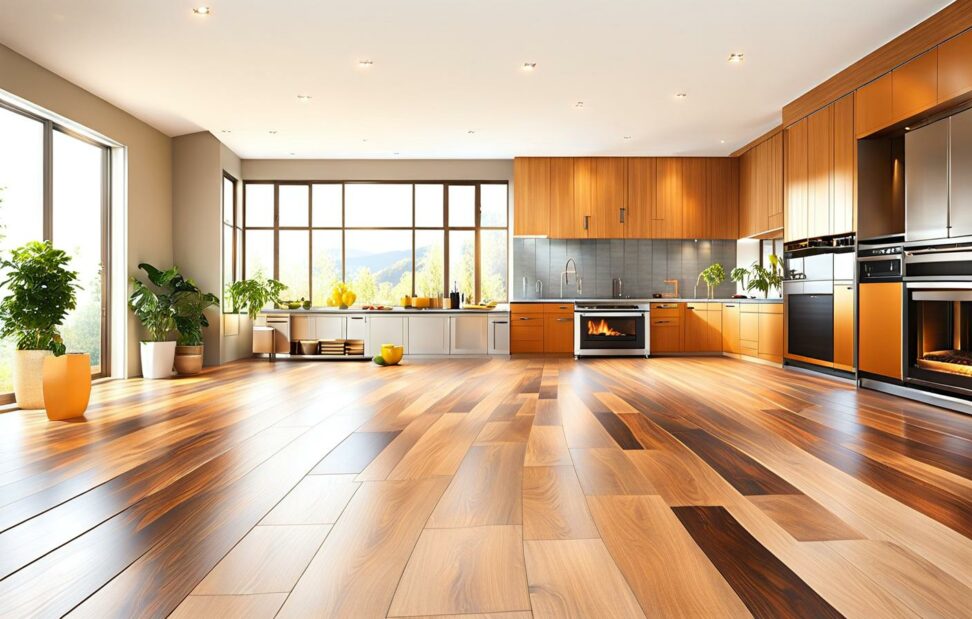Make Your Kitchen Pop With Laminate Flooring's Pros and Cons
If you're dreaming of giving your kitchen floor an affordable yet stylish facelift, laminate flooring deserves a spot on your shortlist. With realistic wood and stone looks achieved through advanced printing technology, laminate offers the beauty of natural materials at a fraction of the cost. This winning combination of fashion and function makes laminate a popular choice for kitchen floors.
But before taking the laminate flooring plunge, it's important to weigh the pros and cons. Laminate is durable and scratch-resistant, making it ideal for high-traffic kitchens. However, it lacks the moisture resistance of tile or luxury vinyl, and it can't match the cozy feel of real hardwood underfoot. Understanding laminate's strengths and weaknesses will ensure you make the best flooring decision for your needs and budget.
Laminate Flooring 101: Construction and Installation
Unlike solid wood or engineered wood floors, laminate flooring contains no actual wood. Instead, laminate planks consist of three fused layers:

- Top layer: A clear melamine resin surface that resists scratches, stains, and fading.
- Core layer: High-density fiberboard (HDF) for stability and durability.
- Bottom layer: A melamine backing that helps repel moisture.
Using advanced printing techniques, the top melamine layer is made to convincingly resemble wood, tile, stone and other materials. Some laminates even incorporate texture to enhance the realistic look.
Laminate floors are designed for easy DIY installation. The planks connect via tongue-and-groove joints that click together like puzzle pieces, without nails or glue required. Known as a floating floor system, the laminate rests on top of the subfloor rather than being nailed down.
Cost-Effective and Durable
Two major advantages make laminate a top choice of homeowners and renters alike:
- Affordable pricing, starting under $1 per square foot.
- High durability to stand up to everyday wear and tear.
While materials like hardwood, tile and vinyl can cost 2-3 times more, laminate's realistic appearance helps it punch above its price point. The tough melamine resists scratches, stains and dents that can mar real wood over time.
Laminate is easy to maintain as well - no need for refinishing or waxing required. Just sweep, mop or vacuum as needed.
How Does Laminate Hold Up in Kitchens?
Kitchens subject floors to spilled liquids, daily cooking messes and heavy appliance use. Does laminate stand a chance against such demands? Let's explore its key strengths and weaknesses.
Resilience Against Surface Damage
Laminate floors earn top marks for resisting the small dings, scratches and stains inherent to kitchen life:
- Pots, pans and fallen utensils won't scuff or scratch thanks to the durable melamine layer.
- Spills like coffee, juice and cooking oils can be wiped up with no staining.
- Colors and designs stay vibrant rather than fading over time.
Regular sweeping, mopping or vacuuming keeps a laminate kitchen floor looking like new for years. The surface stands up to heavy appliance use as well.
Moisture Resistance Has Limits
Here's where laminate shows a key weakness compared to tile or vinyl alternatives. While laminate contains moisture-resistant properties, it is not waterproof:
- Standing puddles from leaky pipes or appliances can penetrate joints and warp planks.
- Prolonged direct water exposure will cause interior swelling and damage.
However, laminate can withstand common spills and mopping. Taking precautions like sealing expansion joints and immediately wiping up spills prevents moisture issues.
Noise and Temperature Considerations
With a hollow core instead of solid wood, laminate floors come with some acoustic and thermal trade-offs:
- Laminate can sound noisy or echoey when walked on.
- It feels colder and harder underfoot than wood or cork.
Using a quality underlayment helps mute noise. Area rugs add warmth and softness in high traffic zones. Slippers or socks also improve comfort.
Range of Realistic Designs
While not as textured as stone or wood, laminate offers plenty of kitchen design options. Looking for a traditional oak floor? Rustic slate tile? Modern walnut planks? Laminate canmimic them all at a fraction of the cost.
Choosing a style that aligns with your cabinets, counters and decor ensures a cohesive look. There are hundreds of laminate patterns and colors to match any kitchen aesthetic.
How Laminate Compares to Other Kitchen Floors
To make the best choice for your needs, it helps to see how laminate stacks up against popular kitchen flooring alternatives.
Laminate vs. Hardwood
Like laminate, hardwood offers timeless style. But at 3-5 times the cost, solid or engineered wood is a pricier investment. Hardwood also shows scratches and dents more easily. However, hardwood feels warmer and more comfortable underfoot. It offers more dramatic variations in graining as well.
Laminate vs. Tile
Tile floors resist water better than laminate, making them the gold standard for moisture resistance. But the hard surface creates fatigue during long prep times. Laminate provides a warmer, kinder cooking surface. Porous grout lines on tile also harbor bacteria and require sealing.
Laminate vs. Luxury Vinyl Plank
LVP wins for waterproofing, but comes at a 30-50% higher cost than laminate. Underfoot feel and installation are comparable. LVP replications of wood grains lack the richness of laminate's photographic imaging. But LVP offers more authentic stone looks.
As a budget-friendly flooring option with chameleon-like styling capabilities, laminate earns its popularity among homeowners. It meets the durability and stain resistance required for kitchen use. With proper precautions against moisture, laminate can deliver years of service and great looks underfoot.
Just weigh its weaker moisture resistance compared to tile or vinyl, and increased noise potential. Laminate makes an attractive, affordable kitchen flooring choice within the right expectations. With a little planning, you can enjoy stylish, practical laminate floors that stand the test of time.